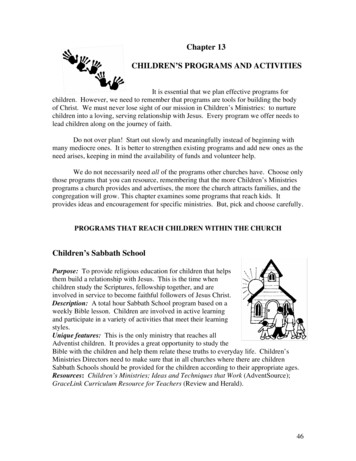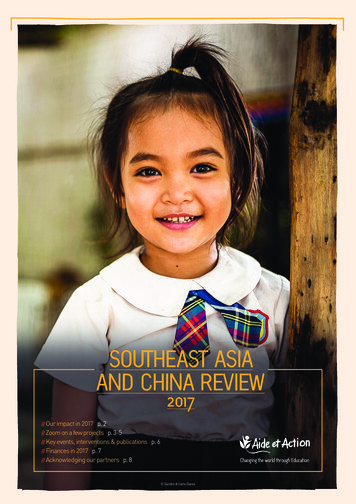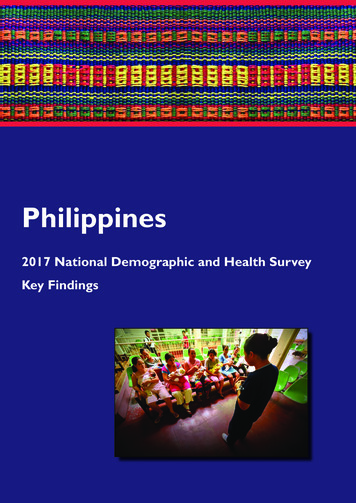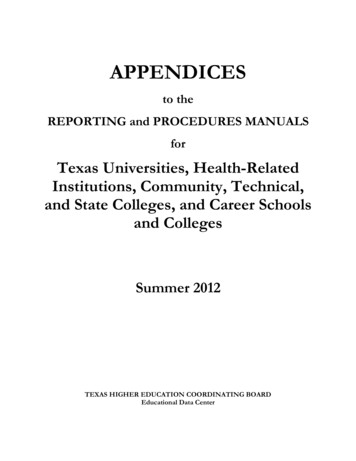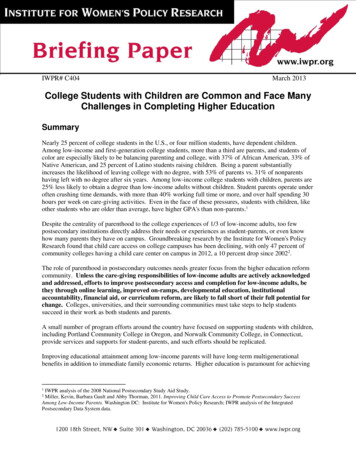
Transcription
IWPR# C404March 2013College Students with Children are Common and Face ManyChallenges in Completing Higher EducationSummaryNearly 25 percent of college students in the U.S., or four million students, have dependent children.Among low-income and first-generation college students, more than a third are parents, and students ofcolor are especially likely to be balancing parenting and college, with 37% of African American, 33% ofNative American, and 25 percent of Latino students raising children. Being a parent substantiallyincreases the likelihood of leaving college with no degree, with 53% of parents vs. 31% of nonparentshaving left with no degree after six years. Among low-income college students with children, parents are25% less likely to obtain a degree than low-income adults without children. Student parents operate underoften crushing time demands, with more than 40% working full time or more, and over half spending 30hours per week on care-giving activities. Even in the face of these pressures, students with children, likeother students who are older than average, have higher GPA's than non-parents.1Despite the centrality of parenthood to the college experiences of 1/3 of low-income adults, too fewpostsecondary institutions directly address their needs or experiences as student-parents, or even knowhow many parents they have on campus. Groundbreaking research by the Institute for Women's PolicyResearch found that child care access on college campuses has been declining, with only 47 percent ofcommunity colleges having a child care center on campus in 2012, a 10 percent drop since 20022.The role of parenthood in postsecondary outcomes needs greater focus from the higher education reformcommunity. Unless the care-giving responsibilities of low-income adults are actively acknowledgedand addressed, efforts to improve postsecondary access and completion for low-income adults, bethey through online learning, improved on-ramps, developmental education, institutionalaccountability, financial aid, or curriculum reform, are likely to fall short of their full potential forchange. Colleges, universities, and their surrounding communities must take steps to help studentssucceed in their work as both students and parents.A small number of program efforts around the country have focused on supporting students with children,including Portland Community College in Oregon, and Norwalk Community College, in Connecticut,provide services and supports for student-parents, and such efforts should be replicated.Improving educational attainment among low-income parents will have long-term multigenerationalbenefits in addition to immediate family economic returns. Higher education is paramount for achieving1IWPR analysis of the 2008 National Postsecondary Study Aid Study.Miller, Kevin, Barbara Gault and Abby Thorman, 2011. Improving Child Care Access to Promote Postsecondary SuccessAmong Low-Income Parents. Washington DC: Institute for Women's Policy Research; IWPR analysis of the IntegratedPostsecondary Data System data.2
family economic security, and parental education yields powerful two-generation benefits, by improvingchildren's economic, educational, and social outcomes.3Student Parents are Common and their Success is Crucial to FamilyEconomic Security.Students with children comprise nearly one-quarter (23 percent) of total college enrollees in2008, or 3.9 million students (IWPR 2013c). Educational achievement for students with childrenbenefits the students themselves, and the families they are raising. Research demonstrates thatincreasing parents’ educational attainment yields positive short and long-term gains for children,in the form of higher earnings, greater access to resources, more involvement in their child’seducation and greater likelihood of their child pursuing a higher educational degree (Miller,Gault, and Thorman 2011; Attewell and Lavin 2007).Underrepresented Students are Disproportionately likely to beParents.Nearly two out of every five African American college students, or 37 percent, are parents.American Indians and Hispanic/Latino students are also disproportionately likely to havechildren, at 33 percent and 25 percent respectively.Figure 1. Proportion of College Students with Dependent Children byRace and Ethnicity, 0%33.4%25.3%Black orAfricanAmericanAmericanIndian orAlaska Native22.1%Hispanic orOther/MoreLatinothan one race20.3%White23.3%17.6%Asian orPacificIslanderTotalSource: IWPR Analysis of 2008 National Postsecondary Student Aid Survey data. National Center of EducationStatistics, U.S. Department of Education (IWPR 2013c).3Attewell, Paul, and David E. Lavin 2007, Passing the Torch: Does Higher Education for the Disadvantaged Pay Off Acrossthe Generations? New York: Russell Sage Foundation. Magnusen, 2007. "Maternal education and children's academicachievement during middle childhood." Developmental Psychology 46(2): 1497-1512.2
Nearly Half of Students with Children are First Generation CollegeStudentsCollege students with children are also likely to be first generation college students. Forty-ninepercent of student parents are first generation college students, while only 29 percent of nonparents are first generation. Half of veteran student parents (51 percent) are first generationcollege students, as are 55 percent of Latino student parents (IWPR 2013c).Over 75 Percent of Single Student Parents are Low-IncomeThirty-three percent of low-income college students have children. , and 78 percent of singlestudent parents are considered low-income (IWPR 2013c).Student Parents Have Higher Unmet Financial Need, Despite HigherRates of Aid and Loans than Non-ParentsStudent parents, and especially single parents, have far lower expected family contributions(EFCs) than their peers. Among single student parents, 62 percent have an Expected FamilyContribution of zero, compared to 20 percent of non-parents, and 18 percent of married parents.Despite the fact that student parents are more likely to receive federal tuition assistance in theform of Pell Grants than non-parents, (43 percent and 23 percent respectively) the average unmetfinancial need of student parents after all aid is still high. Single student parents have an averageannual unmet need of 6,117 compared to 3,650 for non-parent students, and 3,289 formarried parentsi.Figure 2. Persistence and Attainment 6 Years after Enrollment, 2009Parents52.2%15.3%Left withoutReturn32.5%Still enrolledNon-Parents31.9%0%20%14.9%40%Attained Degree orCertificate53.2%60%80%100%Source: IWPR analysis of the Beginning Postsecondary Students Longitudinal Study (04/09).3
Student parents who leave school are more likely than non-parents to state that a lack of financescontributes to their decision to withdraw (55 percent compared to 49 percent) (IWPR 2009).Student parents are more likely than non student parents to leave school without a degree. Aftersix years of enrollment, 52 percent of parents left without a degree, compared to 32 percent ofnon-parents.Among student parents who leave with no degree, 40 percent hold educational debt, and theaverage debt for these students is 8,138 (IWPR 2013b).Student Parents Leave Education with More DebtFor students graduating in 2008, the average cumulative debt one year after graduation for singlestudent parents was approximately 5,000 more than the average debt for non-parents and over 3,000 more than the average debt for a married parent (see Figure 3.).Figure 3. Average Cumulative Undergraduate Debt One Year afterGraduation 35,000.00 29,108.00 30,000.00 25,000.00 24,808.60 23,748.30 20,000.00 15,000.00 11,074.10 13,908.30 10,402.90Class of 2000Class of 2008 10,000.00 5,000.00 0.00Non-parentsSingle ParentsMarried ParentsSource: IWPR calculations, 2000 and 2008 Baccalaureate and Beyond Longitudinal Study. National Center ofEducation Statistics.Student Parents are More Likely to Enroll in Costlier For-ProfitInstitutions, which Contribute to Higher Debt BurdensEighteen percent of all student parents in the United States are enrolled in for-profit institutions,compared to only 6 percent of non-parents. Student parents make up nearly half (48 percent) ofenrollment at for-profit institutions. Average debt one year after graduation is 34,975 for4
student parents who have graduated from a 4-year for-profit institution, 7,597 greater than thedebt of those graduated from not-for profit 4-year institutions, and 12,518 greater than the debtof graduates of 4-year public institutions (IWPR 2013b). In addition to the increased debt burdenassociated with for-profit institutions, these schools are also the least likely to offer on-campuschild care.Student Parents Have Greater Work and Child Care Demands thanNon-ParentsStudent parents work more than non-parents to meet their many financial obligations. Studentparents work 29.2 hours, on average, compared with 21.6 hours among non-parents. In additionto their work demands, 68 percent of married student parents, and 56 percent of single studentparents spend 30 hours or more on child care (Miller, Gault, and Thorman 2011). Thesedemanding schedules underscore the importance of child care availability for student parents.On-Campus Child Care Options are DecreasingStudent parents attend community colleges more than any other type of institution (50 percent),and make up 29 percent of all students at community colleges. Yet on-campus child carefacilities are becoming less prevalent, and community colleges have fewer child care facilitiesthan do four-year institutions. In 2011, 55 percent of public four-year institutions reported havinga campus-based children’s center while 47 percent of community colleges reported having onsite children’s centers (see Figure 4.).Figure 4. Proportion of Public Postsecondary Institutions with OnCampus Child CareSource: IWPR 2013 Analysis of National Survey of Student Engagement Annual Results 2012Even for those campuses that do have child care facilities, they do not meet the parents’ childcare needs. Based on a survey of over 80 agencies, 80 percent of centers maintain waiting lists,5
and the average waiting list was 90 children, or about 85 percent the size of the enrollment of acenter (Miller, Gault, and Thorman 2011).Gender Gaps in STEM Fields Limit Economic Opportunities for SingleStudent MothersWomen make up a large proportion of students at postsecondary schools, earning 62 percent ofall the associate's degrees in 2008-2009. Despite high enrollment rates, there fields of study arestill highly segregated by sex. Out of 35 fields of study, only fourteen have a proportion ofwomen that is equal to or greater than their total enrollment at community colleges (Moughari,Gunn-Wright, and Gault 2012). Over 80 percent of graduates from family and consumersciences, social sciences, legal studies, education and health-related fields are women.Conversely, 80 percent of graduates in construction, mechanics, transportation and engineeringrelated technology fields are men. Gender differences in fields of study are important becausetraditionally male occupations pay higher wages. Creating true economic opportunity throughhigher education requires promoting and preparing women, especially single mothers, for careersin STEM and traditionally male-dominated fields.Policies and Programs for Student Parents are ImperativeSome colleges have recognized the needs of student parents by providing them with additionalresources, like campus child care centers, benefits access services, housing opportunities, referralprograms and scholarships. These promising efforts should be replicated and expanded, andfederal funding for programs such as the U.S. Department of Education's Child Care MeansParents In School Program, and the Pregnancy Assistance Fund, should be strengthened andexpanded. In addition, more states should use the flexibility within within Perkins WorkforceDevelopment Grants to expand supports for students who are raising children while they seek toexpand their credential.ReferencesAttewell, Paul and David E. Lavin. 2007. Passing the Torch: Does Higher Educaton for theDisadvantaged Pay Off Across the Generations?. New York: Russell Sage Foundation.Institute for Women’s Policy Research. 2009. Analysis of 2008 Community College Survey ofStudent Engagement Data.Institute for Women’s Policy Research. 2013a. Analysis of the Baccalaureate and BeyondLongitudinal Study. National Center for Education Statistics, U.S. Department of Education.6
Institute for Women’s Policy Research. 2013b. Analysis of the Beginning PostsecondaryStudents Longitudinal Study (04/09). National Center for Education Statistics, U.S. Departmentof Education.Institute for Women’s Policy Research. 2013c. Analysis of 2008 National Postsecondary AidSurvey Data. National Center of Education Statistics, U.S. Department of Education.Miller, Kevin, Barbara Gault, and Abby Thorman. 2011. Improving Child Care Access toPromote Postsecondary Success among Low-Income Parents. Washington, DC: Institute forWomen’s Policy Research.Moughari, Layla, Rhiana Gunn-Wright, and Barbara Gault. 2012. “Gender Segregation in Fieldsof Study at Community Colleges and Implications for Future Earnings.” Washington, DC:Institute for Women’s Policy Research.iUnmet need is defined as the student budget (tuition and non-tuition academic expenses) minus the EFC and allaid. All aid includes need-based and non-need-based at the federal, state and institutional level and includes privategrants, but excludes private loans.This briefing paper was prepared by Bethany Nelson, Megan Froehner, and Barbara Gault,Ph.D. with funding from Bill and Melinda Gates Foundation and Annie E. Casey Foundation.For more information on IWPR reports or membership, pleasecall (202) 785-5100, email iwpr@iwpr.org, or visit www.iwpr.org.The Institute for Women's Policy Research conducts rigorous research and disseminates its findings to address theneeds of women, promote public dialogue, and strengthen families, communities, and societies. The Institute workswith policymakers, scholars, and public interest groups around the country to design, execute, and disseminateresearch that illuminates economics and social policy issues affecting women and families, and to build a network ofindividuals and organizations that conduct and use women-oriented policy research. IWPR, an independent, nonprofit, research organization also works in affiliation with the graduate programs in public policy and women's studiesat The George Washington University.7
IWPR# C404 March 2013 College Students with Children are Common and Face Many Challenges in Completing Higher Education Summary Nearly 25 percent of college students in the U.S., or four million students, have dependent children. Among low-income and first-generation college students, more than a third are parents, and students of


